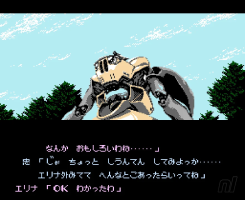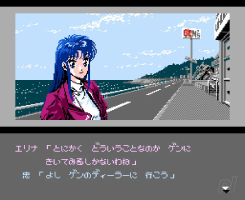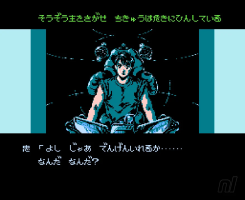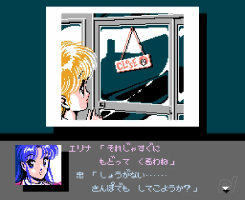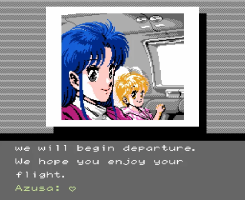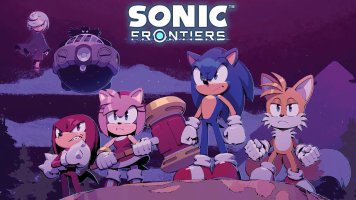"It's famous for being one of the most expensive Famicom games of its time," said Satoru Iwata of Metal Slader Glory in a 1999 interview with Used Games magazine (translated by Shmuplations). Iwata, who became president of HAL in 1993 and then president of Nintendo in 2002, worked as a producer on the game, which took four years to finish in a time when game development was often measured in months, not years. "It's actually kind of amazing that we stuck to it, persevered, and eventually released it," he continued, "but from a management perspective it was a mistake."
Before we get into Metal Slader Glory and its legacy, let's do a quick recap of the history of HAL Laboratory. Formed in 1980, HAL initially created games for computers like the MSX and Commodore VIC-20, and the first president was Mitsuhiro Ikeda, who had previously managed a Seibu computer store visited by Iwata and his friends.
"The gang of us that used the computers at the store spontaneously formed a user group," Iwata recalled in the book Ask Iwata, and when HAL was formed, he landed a part-time job with the company. Iwata was still at university in 1980, but when he graduated in 1982, he immediately began working full-time at HAL. (The name, incidentally, was chosen because "each letter put us one step ahead of IBM," explained Iwata in 2012.)
A year later, the Nintendo Famicom was released, which changed HAL's focus. "The Famicom gave us a totally new platform, changing forever the way that games would be made," recalled Iwata [Ask Iwata, p. 7]. "At the time, a PC in Japan would cost you a small fortune, but the Famicom was only 15,000 yen, making it the obvious choice as a platform for playing games."
HAL produced a slew of successful titles for the Famicom, including PINBALL, Golf, F1 Race, Balloon Fight, and Joust, and HAL even began publishing Famicom titles made by other developers, such as Kabuki: Quantum Fighter from Human Entertainment. Iwata had a direct hand in programming several of HAL's Famicom hits, but he was soon promoted to head of development and took on a more managerial role.
It was as director of development that he noticed some exceptional pixel art being produced by Yoshimiru Hoshi (who goes by the name of ☆Yoshimiru, or simply Yoshimiru). He had been working as a freelancer for HAL, creating art and animation for games like Gall Force and Fire Bam, but in 1987 he was putting together a pitch for what would become Metal Slader Glory. He recalled the moment it was given the green light in another interview translated by Shmuplations:
"When I was getting ready to present the game… well, I suppose you couldn't really call it a presentation. It was an attempt at a design doc, a screen mock-up and a couple of example animations. But, while I was waiting to show what I'd made, I was testing it on the monitor and Iwata happened to walk past. He saw the graphics, and the game was given the go-ahead without the presentation."
It was the exceptional art and animation that piqued Iwata's interest. "My colleagues told me later that he said the graphics looked more advanced than something a Famicom should be able to produce... He wanted to see what would happen if my initial animations were made into a full game, I think." Yoshimiru had cleverly manipulated the Famicom's limited tile-set graphics in order to create large, colourful, detailed character portraits with blinking eyes and moving mouths, visuals that seemed almost unbelievable at the time.
But Iwata's move was a gamble. Yoshimiru's background wasn't in game design, but rather in illustration and model making. After a brief stint as an animator, he had worked for model-kit magazines like Fan Road and Hobby Boy, the latter published by Work House. Then in 1984, he produced a manga called Akuutensou Fixallia, about a mechanic who is transported to an alien world after finding the remains of a mysterious robot, but it was cancelled before the run was completed.
His experience with video games and computers was limited: he only used a computer for the first time when he started at Work House in around 1982/1983. "I loved anime and models but until then I really wasn't interested in games," he said. "It's only when I started working on game-related books at Work House that I gave them any attention."
He quickly taught himself how to do pixel art by watching others. But now, he suddenly found himself as the director of an entire game. He was to provide the art, animation, script, sound effects, and overall vision, but he would rely on others at HAL to do the music and programming.
The game takes the form of a visual novel, and along with featuring some of the best graphics ever seen on the Famicom, it boasted some impressive sound effects, not least the way that each of the characters was given a different sound when they were talking.
Typically, visual novels of the time played the same 'da-da-da-da' noise as dialogue appeared on the screen. "I think most game developers simply accepted that was the way it was, and fans didn't mind, but I always thought it was strange," Yoshimiru commented. So he modulated the pitch to make each character sound unique. "When the male and female characters' speech makes different sounds it ends up sounding like a conversation, right?" Not only that, he changed the speed of the text and sound to reflect characters talking slowly or quickly. These two innovations are something we take for granted in games like the Ace Attorney series today, but they were highly novel at the time.
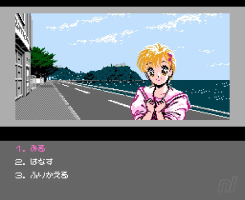
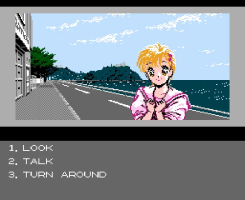
Although the game was never officially localized for the West, a fan translation is available to download
The development of Metal Slader Glory was interminably slow. It took the best part of a year to lay the foundations of the game. "I spent the first six months talking with the programmers about what kind of game I wanted to make and what kind of systems were needed," said Yoshimiru. "After that, it took them a further three months to create the basic systems."
Finding workarounds to allow the ageing Famicom to display huge, detailed images was the main blocker to progress from then on. Yoshimiru gave an example:
"When creating the background and sprites for a scene, a single bank (the Famicom was capable of holding one 128×128 image for backgrounds) was only enough to fill a quarter of the screen. So, when making the scene where the space shuttle leaves earth, for example, that isn't enough space. No matter how much of the screen you fill with black space you still have to draw the ship and the earth on the background. So, I drew the right half of the earth and the left half is just made up of repeating tiles like a mosaic. Coming up with solutions like this were the main reason the game took four years to make."
The sheer size of the resulting game was another problem. "It was only once I'd completed around 80% of the documentation that we started talking about if everything would fit or not," recalled Yoshimiru. "Then, a little later on I had to start cutting things. In the end, not even half of the script I wrote made it into the game." One of the cuts involved the back story leading up to the start of the game, which begins abruptly with Takashi climbing into the cockpit of the Metal Slader and seeing the cryptic message. Instead, Yoshimiru created a manga included in the game's manual that explains the story leading up to this moment.
Even with the cuts, the game weighed in at 1MB, making it one of the biggest Famicom games ever made. It also required an expensive MMC5 chip, Nintendo's most advanced Famicom cartridge chip, which was only used in a handful of games, including Castlevania III: Dracula's Curse. But apparently Nintendo only sold HAL a limited number of these chips.
The story gets a little murky here, and it's unclear whether HAL simply couldn't source enough chips for Metal Slader Glory or whether the company was unwilling or unable to buy more. Whatever the reason, "Very few copies were produced and put in circulation," noted Iwata, making the Famicom game a highly sought-after rarity these days, with boxed copies selling for upwards of $300.
On its release in August 1991, the reviews for Metal Slader Glory were middling. Famitsu scored it 23/40, praising the movie-style graphics, but criticising the linear story and the lack of an option to speed up the text. According to this Waypoint article (which links to a now-removed YouTube video), the sales of the game weren't even enough to cover its advertising budget, let alone development costs.
Not that Yoshimiru was being paid during those four years of development, since he wasn't an official employee of HAL. "My contract was such that I would only make money from the royalties, so I didn't make any money until the game was released. But back then I was still living with my parents, so even if I didn't have any money I was never in danger of starving."
By 1992, HAL Laboratory was facing bankruptcy. The protracted development and poor sales of Metal Slader Glory undoubtedly contributed to the company's dire situation, although this wasn't the only cause.
"We were caught in a vicious circle," said Iwata. "It went like this: we didn't have enough time, so we released games before they were really finished and ready for release, then those games wouldn't sell very well because they weren't very good… which put us in an even more desperate position for our next development."
And this is where Nintendo stepped in. Shigesato Itoi, EarthBound creator and friend of Iwata, apparently suggested that Nintendo president Hiroshi Yamauchi agreed to rescue the developer on the condition that Satoru Iwata was made president. Iwata himself avoided talking about the exact circumstances of the deal: "I'm afraid I'm not at liberty to go into the details [...] but many people at Nintendo had faith in us: 'if they can just unleash their true potential, they'll be a great developer.' People like Miyamoto, who had known firsthand about our contribution to Nintendo since the early Famicom days, were saying stuff like that, and so were several other key people at Nintendo. In the past we had applied ourselves and made solid, quality games that were profitable."
Nintendo didn't acquire HAL Laboratory outright, but the two companies became inextricably intertwined. "Accordingly we left the marketing and sales side up to Nintendo after that, and returned to our original focus of making good games."
On Iwata's first day as president in 1993, HAL faced debts of 1.5 billion yen. "In the end, we paid it off over six years, shelling out 250,000,000 yen annually," he wrote, as chronicled in Ask Iwata. "Of course, we had to cover all our operating costs, so in order to compensate our employees and keep the lights on, we took on a separate line of debt. Eventually we paid everything off, but the process was a burden on a lot of people, so I can't exactly say I'm proud of the experience."
If you haven't gotten around to reading this, you really should
Iwata's first step was to talk to every person who worked at HAL, starting a tradition where he would interview every employee twice a year to find out their strengths and weaknesses, and get a handle on what was going on at the company. And he put a renewed focus on quality.
"I turned to everyone at HAL and said, 'OK, from here on out, every game we create is going to sell a million copies!'" he recalled. "I think everyone thought, 'he's lost his mind.' (laughs) But after that we released Kirby's Adventure, and then Kirby's Dream Course and Mother 2 (Earthbound) on the [Super Famicom]. Thanks to those successes, everyone's attitude changed, and they started saying things during development like, 'if we don't change this it won't sell a million copies!'"
It was those leadership qualities, and the trust and respect he earned from guiding HAL through its darkest hour, that helped to take Iwata to the top job at Nintendo in 2002, ushering in one of the company's most successful eras with the Nintendo DS and Wii.
Meanwhile, Metal Slader Glory returned in 2000, when Metal Slader Glory: Director's Cut became the last title to be officially released for the Super Famicom. It was made available through the Japan-exclusive Nintendo Power game distribution service, whereby customers could take a flash cart to an in-store kiosk to download the game, similar to the service provided for the Famicom Disk System years earlier. Originally there was talk of making a direct Metal Slader Glory sequel/prequel for the Nintendo 64DD, but this was cancelled in favour of the Super Famicom Director's Cut.
Since then, Yoshimiru has produced various books and manga based on Metal Slader Glory, and there was even a Metal Slader gashapon toy. But perhaps the game's most significant legacy is the way it inadvertently helped to push Nintendo and HAL into a long-lasting, mutually beneficial partnership that has endured to this day.



